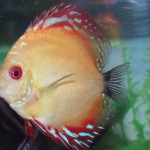The size of the tank you need depends critically on two things:
- how many fish you will be keeping, and
- how big they are.
The keynote to novice fish keepers is NOT to buy a lot of fish and put them into a little, non-aerated tank. They won’t survive long.
Fish get oxygen from the water they live in. Housing too many in too small a tank is like squeezing lots of people into one small, enclosed room forever and expecting them not to suffocate.
It is true that some species like guppies can handle poorer oxygen conditions because of their origins as tropical species from poorly aerated ponds and streams; however, this still does not mean you should overcrowd them.
What To Consider When Buying Aquarium Tank
Volume: Most hobbyists use the rule that every “inch of fish” should have about four liters of water. This means that for five fish, each measuring one inch (about 2.5cm) in length, you should ideally have 20 liters of water in your tank. The same water volume will hold two fish that each measure two-and-a-half inches. If you have a good aerator, you may be able to accommodate a couple more.
However, this general rule applies only to most small freshwater fish. If you have one very large fish (like an arowana), you cannot just measure its length and multiply by four liters. That one 12-inch fish will need much more water and swimming space that 12 liters inch-long fish!
And for small marine fish, you will need as much as 20 liters of water per inch of fish. As a general guideline, a tank 30cm long x 20 cm tall x 20cm deep holds approximately 10 liters of water.
Base calculations on the fishes’ maximum size—a certain tank may do when they are younger, but once they grow bigger, get a larger one or move a few individuals into a separate tank.
Surface Area: Volume is not all that matters. Surface area is another vital point. You may have two tanks that hold identical quantities of water, but if one is tall and narrow while the other is longer and shorter, the tall and narrow one will accommodate fewer and smaller fish than the longer one.
This is because a great deal of oxygen gets into the tank through air-to-water surface exchange. A narrow tank has a smaller surface area than a longer tank of the same volume. The narrow tank thus has “breathing space” for fewer and smaller fish. Besides, the shape of your aquarium tank can affect your fishes’ behavior.
Swimming Space: A tall, narrow tank has less swimming room than a longer, shallower one. Most fish do most of their swimming horizontally rather than vertically, and large, long fish will not be able to turn in a narrow tank.
Imagine being confined to a space where you cannot stretch or turn around—it is very cruel to keep a big fish in a tank too small for it to swim in comfortably. Bigger fish need ponds or large, custom-built aquariums.
















